| ||||||||||||
|
| ||||||||||||
![[Back To Archive]](../../../images/backtoarchive.gif)
| ||||||||||||
 |
Between a rock and a hard place Short Take - June 27, 2002 Evelina M. Tainer, Chief Economist, Econoday To no one’s surprise, the Federal Open Market Committee (FOMC) unanimously voted Wednesday to leave its federal funds rate target unchanged at 1.75 percent after a two-day meeting. Everyone focused instead on the Fed’s post-FOMC statement. In fact, the statement didn’t reveal anything new about the Fed’s thinking on current events, though it did suggest that the economic recovery was indeed in place. “The Committee expects the rate of increase of final demand to pick up over coming quarters, supported in part by robust underlying growth in productivity, but the degree of the strengthening remains uncertain.” The funds target now stands at 1.75 percent for a seventh straight month. But over the last ten years, as shown in the chart below, the funds target has stood unchanged for even longer periods of time. The target stood at 3 percent for 17 months in the early stages of the recovery following the 1990-91 recession. Oddly enough that recession, like the recent one, was also considered short and mild at the time. It seems that mild recessions have the misfortune of being followed by mild recoveries. 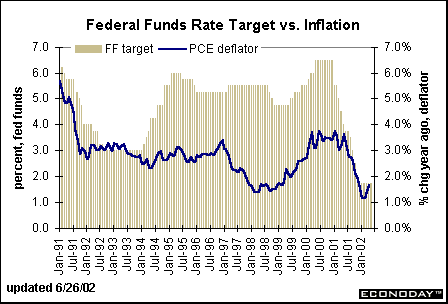 Each recession and subsequent recovery is different. The Fed allowed the funds rate to remain at a low 3 percent in 1992-94 to help the banking system shore up its capital. This time, a different aspect of the financial system is giving the U.S. economy problems. The stock market initially underperformed because corporate profits and economic growth seemed sub-par for equity investors. Now, the stock market is suffering from a loss of confidence due to corporate malfeasance that standard auditing practices have not been able to ferret out. While the Fed should not be determining monetary policy solely on stock market performance, there is no question that the path of equity prices impacts capital consumer spending. Without question, current Federal Reserve monetary policy remains accommodative. It isn’t the nominal federal funds rate but the real inflation-adjusted rate that determines whether the Fed is pursuing accommodative or restrictive policy. Notice that the inflation rate was running around 3 percent in 1992-93 when the funds target also stood at 3 percent. Today the inflation rate (measured by the year-over-year change in the deflator for personal consumption expenditures) is running around 1.5 to 2 percent, also about the same pace as the funds target. Treasury Market Treasury yields dropped sharply on Wednesday, but it had nothing to do with the Fed’s announcement that the federal funds rate target would be left unchanged. Yields are down in June from the May average because of the latest collapse in equity prices. On Wednesday, news that WorldCom may likely declare bankruptcy after mis-stating earnings by $3.8 billion dollars led to a rout in the stock market and a flight to safe-haven investments (Treasuries). An afternoon rebound in the stock market didn't change the picture for the Treasury market. 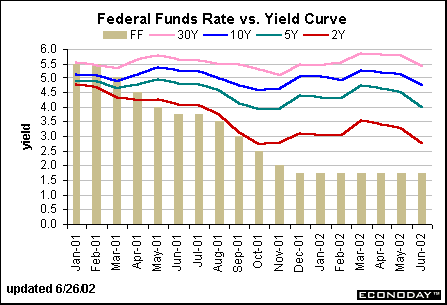 After all is said and done, it is possible that current yields on Treasury securities are more in line with the federal funds rate target. Earlier this year, bond investors anticipated a rapid economic recovery and pushed up yields in anticipation of a quick succession of Fed rate hikes beginning as early as June. In fact, Wall Street economists and Fed officials (including Chairman Alan Greenspan) warned that the economic recovery would be slow and soft this year. It was unreasonable expectations among investors (both bond and equity) that created the disappointment when economic indicators began to signal only modest recovery. Mortgage Market Judging solely by the small movements in the 30-year mortgage rate, one would never know that the funds target was decreased from 6.5 percent to 1.75 percent in less than a year's time. Mortgage rates, which are tied to yields on the 10-year Treasury note, have moved in a relatively small range over the past 18 months. 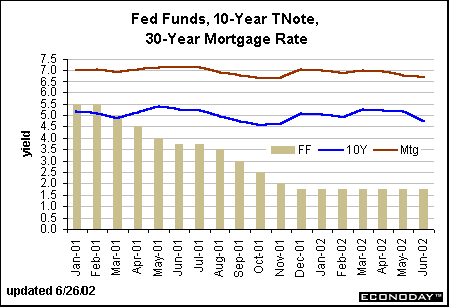 Until June, the spread between the 30-year mortgage rate and the 10-year Treasury note was on a declining trend. (When the final figures for these rates are available, the widening in the spread may be smaller than indicated here). When the Fed initially started to reduce the funds target more than a year ago, it counted on a subsequent increase in consumer demand for interest-sensitive items. Indeed, the housing market has been soaring throughout this period - despite the fact (and maybe because of it) that a collapsing stock market is eroding consumer wealth. 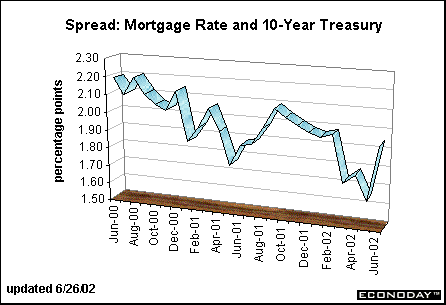 Lower interest rates do spur consumers into spending more money. This was tested and proved by the zero-interest borrowing rates offered by automakers last fall. Many credit card companies are also offering zero-interest on either transferred balances or new purchases. Some sectors of the retail market, although not all, are performing well, but it is more difficult to see whether the zero-interest on credit cards will have the same stimulative impact on the economy that the auto incentives did. While most economists and market players are still expecting the Fed to raise the federal funds rate target later this year, the extra time between now and then could see the introduction of more low- or zero-rate incentive programs. Stock Market To a large extent, the equity market has ignored the Fed. Oh yes, equity markets will rise and fall on the wise words of Chairman Greenspan, but after all is said and done this year, the Fed and the economy seem irrelevant. One of the major issues stems from unreasonable investor expectations. Late last year, economists and Fed officials predicted that the economic recovery would be slow and soft in 2002. But after a couple of robust economic figures, equity investors were off to the races -- the economic and corporate-profit picture was thought to be stronger, sooner. When economic indicators began to only meet expectations, they seemed weak to equity investors. And then the big trouble happened when the number of corporate scandals multiplied geometrically. To top it off, the geopolitical situation also began to deteriorate. Daily terrorist attacks in the Middle East only add to the fears of U.S. investors. 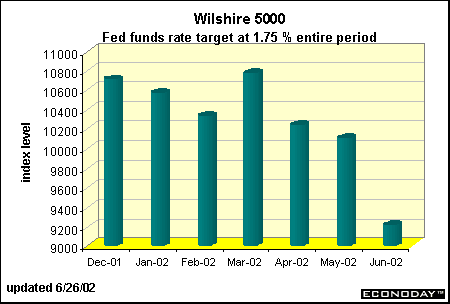 It is difficult to say whether the Fed saved the day or not on Wednesday after the market plunged on the WorldCom news. Immediately after the Fed’s announcement that rates would be left unchanged and the bias would remain in neutral, the stock market fell even further. However, by the closing bell, stock prices had not only gone back to neutral, but the Nasdaq composite index and the Russell 2000 managed to eke out a slight gain (although not the Dow, S&P 500, and Wilshire 5000). Some analysts had suggested that the financial system is sufficiently in shambles to trigger a rate cut by the Fed. Yet, a reduction in the funds rate would have been terrible news for the stock market! In the past couple of months, equity prices have collapsed every time that Alan Greenspan says something neutral about the economy. Equity investors are looking for positive news that economic growth - and therefore corporate profits - will accelerate. At this point, an indication by the Fed of a rate hike, that the economy was growing faster than expected, would likely be viewed in a favorable light. Bottom Line The Fed is stuck between a rock and a hard place these days. It needs to make sure that sufficient liquidity exists in times of potential crisis in the financial system. But the Fed also needs to consider the economic environment. This environment includes economic growth and the prospect for inflation. The direction of the stock market can impact consumer and capital spending. A loss of confidence in the stock market could certainly affect consumers’ feelings about their (declining) wealth. In addition, the foreign exchange value of the dollar has been in declining mode recently. A falling dollar has advantages and disadvantages. The weaker dollar will help exporters sell overseas as the price of U.S. goods and services declines. However, it will also raise the cost of imports. Rising import prices can be inflationary. In the past 20 years, however, importers have largely used a weaker dollar to gain market share and have generally limited price hikes on their goods. This is, no doubt, an issue that the Fed needs to consider. The Fed’s decision to focus their post-FOMC statement on the economy, rather than on the financial markets or the falling value of the dollar, may indeed have saved the day on Wednesday. Market players need to hear that the economy is basically sound. Current events may be forcing stock prices down, but eventually, the corporate scandals should be less important to price movements than the fact that the economy and corporate profits are growing nicely. It just may take a little while. |